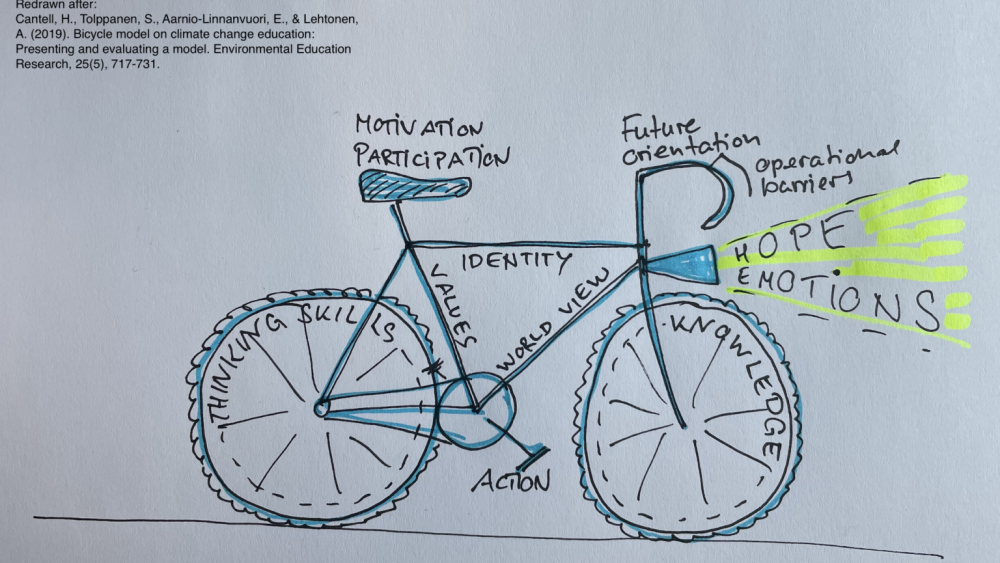Sometimes looking at different models of what is important when teaching about complex topics can be really helpful to look at our teaching in a new way, like the Head-Hands-Heart model we shared a while back. I stuck the drawing above to our coffee corner in my office, because I think it represents a really useful model for thinking about teaching about topics like sustainability, or climate change (which it was originally developed for). The model was developed by Cantell et al. (2019), where they used research in Climate Change Education and combined all the important elements into the “bicycle model”.
The model uses the analogy of a bicycle with its essential components to move forward:
- Two wheels. In the model, one represents knowledge, the other thinking skills, both of which are necessary and need to play together, but neither is sufficient on its own.
- A frame. All new knowledge and skills will be brought together and interpreted through the lens of the learner’s identity, values, and world view.
- Chains and pedals. This represents the “real life” action that is necessary to make things move.
- The saddle. In order for people to be willing to ride the bike of climate change action, motivation needs to be supported, and often that means doing things in a community and participating in something bigger.
- Brakes. Not all action will lead to the desired results, sometimes there are barriers to operation, and they need to be understood and dealt with (here, in my opinion, the analogy breaks down a little bit, since the breaks on a bike are actually serving a desirable purpose in a bike. But maybe we also sometimes need to slow down and re-evalute?)
- The lamp. This signifies the importance of emotions, and especially of hope, in order to scout out and decide on the way forward.
- A handlebar. This is the future orientation, the vision of where to go and how to steer in the right direction to get there.
In their evaluation, Cantell et al. (2019) find that the model is useful in visualizing the complex nature of CCE, keeping it in mind when planning teaching, and even using it as a tool to evaluate teaching. It supports pedagogical reflection and I really like how easy it is to grasp all the important elements without a lot of explanations. Interestingly, the brakes that I criticize above, too, are also discussed critically, with some of the experts disagreeing with the authors on whether or not they should be included. But I agree with the authors that people need to be aware that there are barriers and what they are, so they can prepare adequately and don’t get frustrated by something that would have been foreseeable, and that discussion of common barriers helps understand each other and our behavior, so we can more easily cooperate.
The discussion-part on possible future developments of the model is also super interesting. We need collaborative action, so should we have a tandem instead? But that would take away agency from one of the cyclists, and also it would be much more difficult to move the tandem alone, even though sometimes that might be necessary. But they suggest to draw several bikes together to include that aspect, which works to make the point, but which I would then probably leave to the imagination of the reader.
How does this model help you in thinking about your teaching about sustainability? How would you modify it, or what would you use instead?
Cantell, H., Tolppanen, S., Aarnio-Linnanvuori, E., & Lehtonen, A. (2019). Bicycle model on climate change education: Presenting and evaluating a model. Environmental Education Research, 25(5), 717-731.

